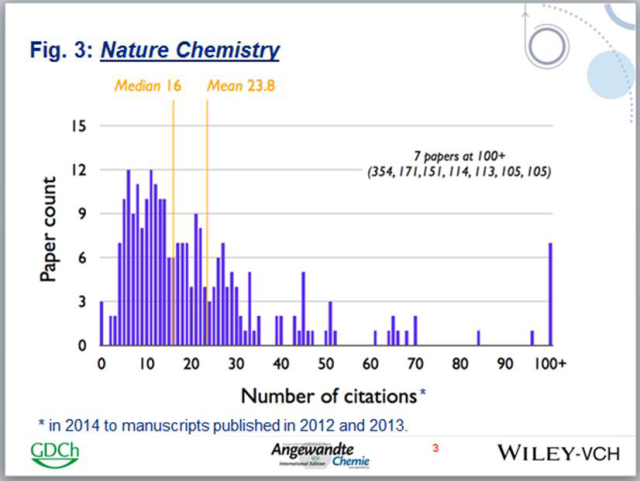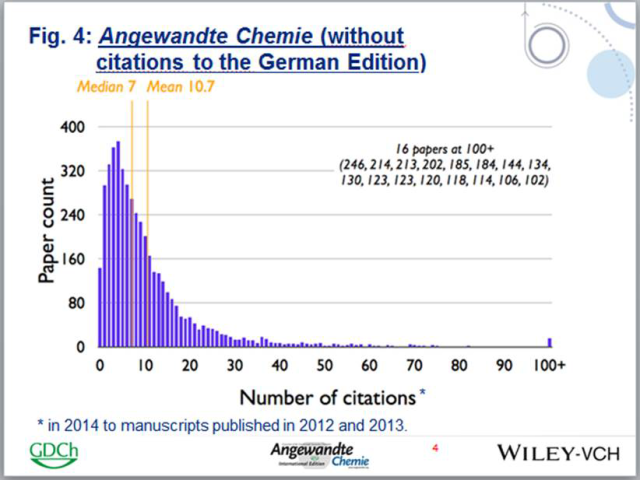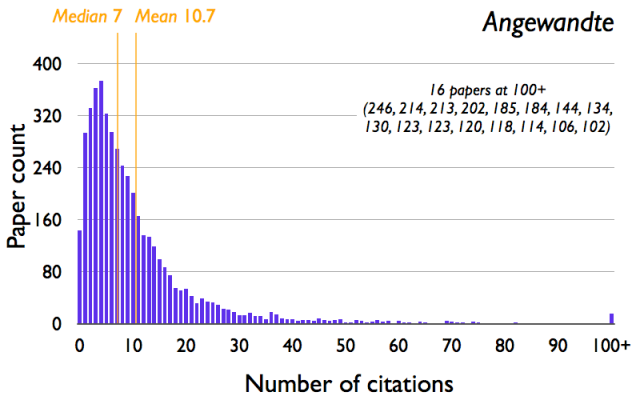Let me just flag up to those of you who aren’t aware of my day job, I’m the Chief Editor of Nature Chemistry; best I put that at the top of this post considering the subject matter…
***See updates at the bottom of the post***
Many thanks to a reader of this blog for forwarding to me an email that they received from Angewandte Chemie thanking them for being one of their ‘outstanding referees’. I applaud such referee-recognition efforts; more journals should do this.
What caught my eye, however, is that the final paragraph of the e-mail mentions statistics related to Angewandte Chemie (and one other journal; can you guess which one?), backed up with 6 figures. First are a couple of graphs showing where submissions to Angewandte Chemie come from (for 2001-2015) and the geographical breakdown of referees (for 2008-2015). It appears that, in 2015, more submissions came from East Asia (somewhat unhelpfully not defined) than any other region and that more referee reports came from Germany than any other country. I don’t feel that I can reproduce the actual graphs here because I did not make them and nor have I sought permission to reproduce them (hey kids, we call this part of the blog post ‘foreshadowing’).
After discussing submissions and referees, the final paragraph goes on to discuss citation metrics in a somewhat contradictory fashion; I’m going to quote from the e-mail now and assume this won’t get me into any hot water (legal or otherwise):
“Too many scientists are obsessed with metrics these days. Figures 3-6 in the attachment demonstrate that Angewandte Chemie publishes indeed many highly cited papers (one only has to look at absolute numbers).”
Which is a bit weird, no? Hey everyone, too many people are obsessed with metrics these days, so here are MORE metrics for you to look at. Hmm.
Now, you know what, I am going to reproduce figures 3 and 4 from the e-mail that Angewandte Chemie sent to its outstanding referees. The reason that I feel on pretty firm ground doing this (despite Wiley’s history of going after bloggers who have reproduced figures from their journals) is that figures 3 and 4 are, with only minor modifications, mine. They first appeared on this blog in a post about citation distributions in chemistry journals.
Here’s figure 3 from the e-mail (top) and my original (bottom).


And here’s figure 4 from the e-mail (top) and my original (bottom).


Pretty similar huh? Same colours, same fonts… – well, that’s because they are clearly the original images from my blog post.
Did Angewandte Chemie ask my permission to reproduce these figures? No.
Did Angewandte Chemie acknowledge in the e-mail that they sent to their referees where these figures came from? I don’t think so (at least not as far as I can tell; perhaps the figures contain hyperlinks, but in the flat version forwarded to me, there is nothing that appears to attribute the figures to me).
What Angewandte Chemie have done, however, is to add logos for GDCh, Angewandte Chemie and Wiley-VCH to the bottom of each figure. Stay classy Angewandte, stay classy. You are now the Daily Mail of chemistry publishing. You couldn’t even be bothered to get the data yourself and re-plot it!
To be fair, they have invested a huge amount of time and effort to add a title and a footnote to each figure, but I’m not sure that means you can ignore where you got the actual figure from.
Now, I get the impression that Angewandte Chemie is unhappy with my citation-distribution blog post. ‘Why?’, I hear you ask. Well, we also get treated to figures 5 and 6. Figures 5 and 6 from the e-mail that they sent to their referees are not my figures, so I will not reproduce them here (take note, Angewandte). I will, however, describe them to you. Figure 5 basically puts the data from figures 3 and 4 onto a single graph, but retains the y-axis scale from figure 4. What this does of course, is put the Nature Chemistry data in the noise. This figure very clearly proves that Angewandte Chemie publishes more papers than Nature Chemistry; I’m pretty sure there are simpler ways to plot this, however.
Now, figure 6. Figure 6 takes the portion of figure 5 that looks at the citation range from 40-100+ citations (except, of course, they simply use the label ‘100’, not ‘100+’ like I did on my graphs… c’mon Angewandte, attention-to-detail folks!). Now, what this graph shows is that when you consider citations in 2014 to papers published in 2012 and 2013, Angewandte Chemie has many more that have accumulated 40-100+ citations than Nature Chemistry. This is not surprising. Angewandte Chemie publishes many very good papers and many highly cited papers. And considering that in 2012-2013 it published almost 20 times as many papers (reviews and research papers) as Nature Chemistry, of course it’s going to have more.
The purpose of my original blog post was, for the most part, to examine citation distributions – it was a follow-up to another blog post that looked in detail at what contributed to Nature Chemistry‘s 2014 impact factor. Sure, I can see how the post could come across as a citation pissing-contest, but the only specific comparisons I make in the text of the post are somewhat superficial and are between Angewandte Chemie and the Journal of the American Chemical Society (JACS) and between Angewandte and Chemical Science. I explicitly pointed out that the y-axis is very different across the charts I plotted for 6 different journals. I did offer a way in which you could compare journals if you wished to, by considering the percentage of published items with a given number of citations. The only way to make any comparisons is to normalize for quantity (and even then it might not be all that meaningful).
Anyway, I find it interesting that Angewandte Chemie compared itself to Nature Chemistry in its e-mail to its referees. I thought I would be helpful and do the comparison for them to JACS; the graphs are below. In terms of published items, the 2012-2013 counts are 4572 (Angewandte) and 5939 (JACS), so roughly similar – well, much more similar than Nature Chemistry and Angewandte for a start.
Here’s my version of figure 5 from Angewandte‘s e-mail to its referees (only with JACS data instead of Nature Chemistry):

And here’s my version of figure 6 from Angewandte‘s e-mail to its referees (only with JACS data instead of Nature Chemistry):

Well, look at that, JACS publishes more highly cited papers than Angewandte Chemie! They also publish more papers in total too. Read into that what you will.
So Angewandte, if you do fancy using these graphs in your next e-mail to your referees, don’t put your logo on them and do acknowledge where you got them from – but I do give you my permission to re-use them for that purpose.
With regard to your unauthorized and unattributed re-use of my figures in the e-mail that you have already sent, I kindly ask that you send a follow-up e-mail to everyone that received it noting where the images came from, including a link to the original blog post.
I don’t know if your use of my images in an e-mail that went to hundreds of people counts as ‘publishing’ them, but regardless, it seems only fair to give credit where credit is due – just like you are doing with your outstanding referees.
UPDATE 8:45 am, 15 March: @angew_chem have apologized on Twitter and have promised to follow up with the referees; I thank them for getting back to me so promptly and for doing what I asked.

UPDATE 3:45 pm, 15 March: I’ve had a very nice e-mail from Angewandte Chemie apologizing for their oversight and they also shared with me the draft of the follow-up e-mail that they intend to send to the referees and asked me for any comments I had concerning it. I take it back, they are not the Daily Mail of chemistry publishing after all.
UPDATE 3:35 pm, 17 March: As pointed out in the comments below, and also confirmed in e-mails from others, Angewandte has indeed followed up with the referees as they said they would. I thank them for doing this so quickly and without any fuss whatsoever.























